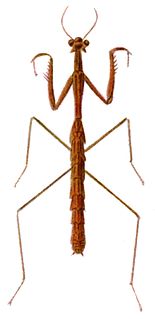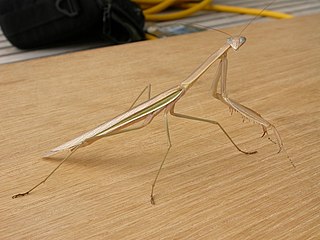
The Pterygota are a subclass of insects that includes the winged insects. It also includes insect orders that are secondarily wingless.

The Exopterygota, also known as Hemipterodea, are a superorder of insects of the subclass Pterygota in the infraclass Neoptera, in which the young resemble adults but have externally developing wings. They undergo a modest change between immature and adult, without going through a pupal stage. The nymphs develop gradually into adults through a process of moulting.

A tegmen designates the modified leathery front wing on an insect particularly in the orders Dermaptera (earwigs), Orthoptera, Mantodea, Phasmatodea and Blattodea (cockroaches).

Extatosoma tiaratum, commonly known as the Giant prickly stick insect, the spiny leaf insect, Macleay's spectre, or the Australian walking stick, is a large species of stick insect endemic to Australia. The species has the Phasmid Study Group number PSG9.

Acrophylla titan, the titan stick insect, is the second-longest stick insect found in Australia.

The false garden mantis is one of the most common species of mantis in Australia. Females reach 70 mm while males reach 50 mm.

Eurycnema goliath, the Goliath stick insect, is one of the largest stick insects in Australia. The first instar of a nymph is small, brown, and ant-like, without wings, however the adult insects are green and yellow, though colors can slightly vary, are very large, and have wings.
The pink-winged phasma is a species of phasmid that is endemic to Australia.

Stick mantis and twig mantis are common names applied to numerous species of mantis that mimic sticks or twigs as camouflage. Often the name serves to identify entire genera such as is the case with:

Bolbe is a genus of praying mantises, sometimes called by the common name Ground Mantis, that is found in Australia. It is in the family Iridopterygidae of the order Mantodea, the mantis.

Bolbe pygmaea is a species of praying mantis in the genus Bolbe in the family Iridopterygidae of the order Mantodea. It is endemic to Australia.

Tenodera australasiae, the purple-winged mantis, is species of praying mantis. Found in Australia, it is common in most parts of Brisbane (QLD). Both males and females are capable of flight. The species has not been shown to be parthenogenetic.

The Orthopterida is a superorder of the Polyneoptera that represents the extant orders Orthoptera, and Phasmatodea. The Orthopterida also includes the extinct orders Titanoptera and Caloneurodea. There is general consensus of monophyly in this superorder, based on reduction of the second valvulae, an ovipositor derived from the gonoplac, and an enlarged precostal region on the forewing.

Mantises are an order (Mantodea) of insects that contains over 2,400 species in about 430 genera in 15 families. The largest family is the Mantidae ("mantids"). Mantises are distributed worldwide in temperate and tropical habitats. They have triangular heads with bulging eyes supported on flexible necks. Their elongated bodies may or may not have wings, but all Mantodea have forelegs that are greatly enlarged and adapted for catching and gripping prey; their upright posture, while remaining stationary with forearms folded, has led to the common name praying mantis.

The Australian Museum is a heritage-listed museum at 1 William Street, Sydney central business district, New South Wales, Australia currently under renovation. It is the oldest museum in Australia, with an international reputation in the fields of natural history and anthropology. It was first conceived and developed along the contemporary European model of an encyclopedic warehouse of cultural and natural history and features collections of vertebrate and invertebrate zoology, as well as mineralogy, palaeontology and anthropology. Apart from exhibitions, the museum is also involved in Indigenous studies research and community programs. In the museum's early years, collecting was its main priority, and specimens were commonly traded with British and other European institutions. The scientific stature of the museum was established under the curatorship of Gerard Krefft, himself a published scientist.
















